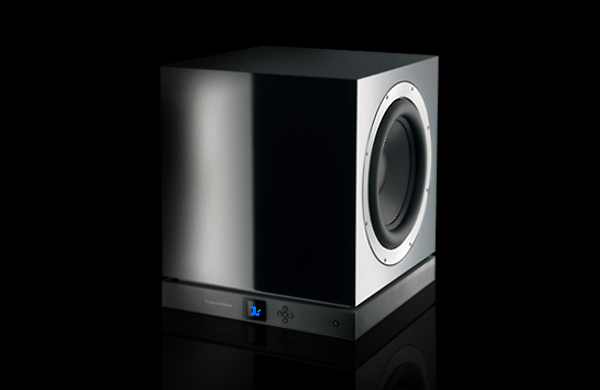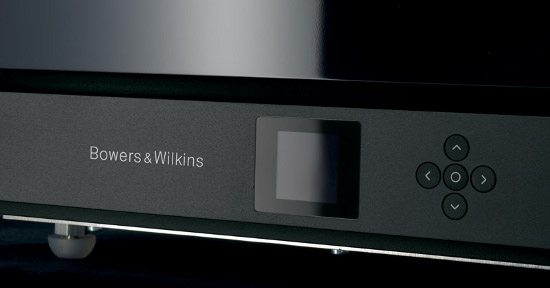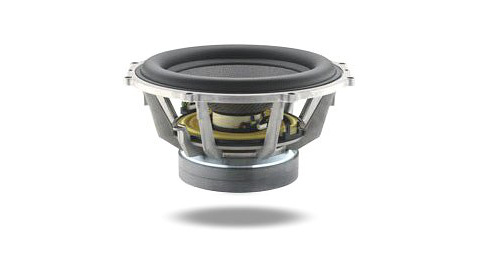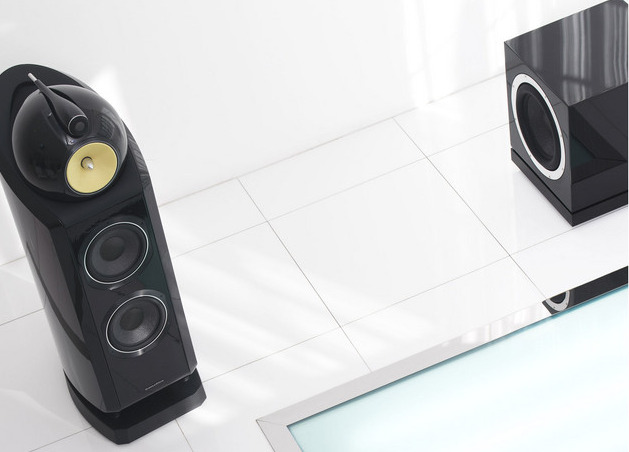BOWERS & WILKINS DB-1
The DB-1 subwoofer is a simple monolithic cube finished in flawless piano lacquer. It extends ca half a meter to any side and is incredibly heavy. I had to pull the 50 kgs of the sub upstairs and it was not an easy job, rather an Olympic discipline, as unlike an amplifier there are no handles on the device. As such the DB-1 is among the most inconvenient pieces of hifi that I’ve had to move around my house.

The clash of thunder
For sure, if another pair of hands is available, the things get less complicated. That was not my case, however, and I could not postpone auditioning to the other day – I was too excited to wait. Fortunately, neither Bowers nor Wilkins did not let my expectation vanish.
Designing the elite
The manipulation with the DB-1 is so clumsy because it is too big in its crate, and when unpacked it is difficult to get a firm grip on it as there are two sizeable bass cones on its sides and one platform packed with electronics at the bottom. The two 300mm woofers are by 20% bigger than those in the B&W’s 800 Diamond flagship, the design principles are identical, that is based on Rohacell.
The Rohacell is not Bowers & Wilkins’s proprietary material – they source it from German Evonik Industries that have developed it for demanding applications in aerospace, automotive and medicine industries, not for audio. It is not based on paper or fabric, like many audio afficionados like to say, but on foamy polymer structure (polymethacrylimide, chemically) that is both extremely light and extremely stiff. The polymer structure is sheeted between two layers of carbon fibres to give it final dynamic properties. The company literature says that, though the cones are big in diameter, they do not suffer from deformations during the pistonic movements of the membrane and have exellent self-damping properties. By this the Rohacell cones should exhibit up to 10dB improvement in dynamic behavior, which is an astonishing figure, considering the audio business where 1dB means a lot.
An Analog Devices DSP chip is the real brain of the DB-1 - it controls the sub’s auto calibration process and other settings - whereas a class D 1000W amplifier takes care of sufficient output power. By using the digital amplification the dimensions of the subwoofer could shrink to the aforementioned cubature, it is not a long time ago when subwoofers of similar parameters were as big as cupboards.
The DSP is a keyword for the DB-1’s performance. For sure, the sub has to be connected to a processor/amplifier before you can make a use of it. The DB-1 sports both single-ended RCA and balanced XLR connections, unlike its peers it does not offer main speaker connections, however. For pure high end applications, be it music or home cinema entertainment, the speaker level connections usually deteriorate the quality so I did not miss this feature.
The XLR input of the DB-1 supports only a single channel operation and Bowers & Wilkins recommends to use Y-links to monophonize a stereo signal. Audio purists will not like it and will perhaps prefer the stereo RCAs for that reason but the result is going to be the same in the end – the DB-1 sums both channels into one on the input of its internal D-class amplifier. If you need to use two separate subwoofers for ultimate stereo performance down to the lowest octaves I recommend not using the two DB-1s: the dual woofers radiate in an omnidirectional fashion and using four such drivers may result into problematic behavior in a room, including sound wave cancellations. Also DSP-ing the frequency response with the dual DB-1s will be next to impossible. The B&W DB-1 subwoofer was designed to give the ultimate performance as a single unit.

The moment of falling in love
There are two options of operating the DB-1: either with four buttons at the subwoofer’s base or via a laptop. No need to say that the computer interface is much more user-friendly and intuitive.
To control the DB-1 via the computer it needs to be connected with the provided USB cable, first you have to download installation software, however. The installation is fully automated and the program gets all the necessary tools (Microsoft Visual C++, dynamic libraries and other utilities) from B&W’s software depot – an internet connection is required therefore. As soon as the installation procedure is completed the program installs a small DB-1 icon on your desktop that launches the subwoofer control SubApp interface. The whole set-up takes no more than 15-20 minutes of looking at progress bars and various notifications – afterwards a small green square announces that it is time to play. The moment of switching the DB-1 on is the moment of falling to love: there is a cool monochromatic minidisplay on the sub that lends to the sub a kind of ultra-high-end appearance (apart from being very functional). In the standard configuration the display faces a listener (and the woofers fire to the sides). If you prefer a different placement and does not want to miss the display, no problem, just turn the sub upside down, release few bolts, rotate the base by 90 degrees and bolt it back. Very simple, very clever.
If there is no momentary possibility to use a computer with the DB-1, all the parameters can be adjusted via the four tiny push buttons at the base. I see this as a certain asset over the competitor – the Velodyne’s DD-12+ that does not allow full manual control. Even if you have to buy a simple laptop just for the sake of controlling the DB-1 it pays out – all the changes and adjustments you make to the sound can be heard on the fly.
Unlike competitors that prefer setting all the basic parameters (phase, low pass and volume) before running the DSP equalization the DB-1 starts with the latter. You only need to hook up the provided calibrated microphone and the B&W’s soundcard and hit the start button, the rest is done automatically. Instructions for use that are part of the package are very detailed and friendly, I did not experience any unexpected situation during my life with the DB-1. It is obvious that the engineers had tested the unit before the manual was conceived as some literature that comes with other products seems to be written only for their makers, not for their users.
The DSP-ing of the DB-1 is after few frequency sweeps finished with the compensation of room modes. When I experimented with the Velodyne DD-12+ recently it was possible to freely adjust or alter the compensation by setting exact frequency, the compensation dB value and its Q-factor. The DB-1 saves the compensation curve internally and you cannot change its parameters. However, the sound significantly improved after the compensation when I checked the peaks and dips with a measurement software.
The SubApp interface provides two screens. The first allows a user to set phase, low pass and volume, the other is an alternative to Velodyne’s CONTOUR mode with a five-band graphic equalizer to fine tune the sub’s performance to program material. The boost of frequency dips is possible only by max +5dB to prevent the user pumping further energy into the black hole and overloading the DB-1’s amplifier.
What I liked very much was the way of setting the sub’s correct volume. With other subwoofers there is a volume knob or a digital volume control that allows increasing the volume from zero to maximum and it is up to you to find the appropriate level. In the DB-1 the volume is set by selecting one of three options for the output voltage of source component. B&W assumes that this value should be provided by the equipment manufacturer. As the DB-1 was connected directly to the RCA outputs of my Accuphase DP-78 SACD player I used -6dB (2.5V) setting of the DB-1. If you need to further adjust the volume, it is possible vie fine-tuning by +/-6dB in the SubApp. I made a small +1dB correction that gave me the best subjective in-room response.
Should you are blending the DB-1 with other Bowers & Wilkins speakers it is very easy to choose the type of your speakers from drop down menu – that automatically sets the correct low pass value. In other cases you have to rely on your ears or on a measurement software. I tested both approaches and arrived to identical values. The ears-only based approach is described in the article written by Bob Katz. The crossover roll off can be switched between 12dB and 24dB/octave, the phase can be changed in increments of 90°.
The whole procedure of setting the DB-1 looks complicated but it is not in reality and you should be done within an hour. The nuancees can be fine-tuned in the next few weeks. I highly recommend backing up the settings on your hard drive for later use or recovery. Also, if you make a significant change to your room, e.g. moving a sofa, adding bass traps, moving the subwoofer or similar, rerun the auto-calibration.

The elite sound
The Exotic Dances from the Opera (Reference Recordings, RR-71CD) is full of dynamic symphonic pieces that can possibly breakdown the walls of any listening room, provided that a system is capable of full dynamic scale and full frequency extension. With the DB-1 it is guaranteed that both the conditions are fulfilled with an ample reserve. For example, I listened to the Minnesota Orchestra performance of Rabaud´s Dances from Marouf, Cobbler of Cairo, a piece that was written back in 1914. It is a very rich and, as Reference Recording´s liner notes put it, luxuriantly harmonized music. No later than in two minutes into the track a listener is seduced by a rhythmic interplay that evokes Ravel´s Bolero – the music bubbles in endlessly revolving cascades with almost hypnotic quality, not unlike Tangerine Dream did with their analog synthesizers many years later. Floating flutes and an oboe are underlined by muted strings and soft strokes of a drum. The DB-1 is seemingly silent; neither the flutes nor the oboe for sure do not have any significant energy in its passband, still, the cones of the subwoofer are gently moving to help create a sense of scale and body and to recreate the ambience. When the drum kicks in the sub gets alive as it does in soft passages of a harp’s glissandos (The harp is one of the rare instruments that can reach down to the 20Hz octave, similarly to contrabassoon and organ pipes. Ed.) .
There were frequent moments during my life with the Bowers & Wilkins DB-1 when I stood up and switched the subwoofer off just to make sure that it contributes to the music, for it did not like working hard – the solo oboe part in Saint-Saens Bacchanale can be the example. However, when the sub was disconnected, the music suffered. The soundstage did not shrink. The instrument did not lose its presence. The bass was not deeper. What happened was that the whole picture was less alive, less lifelike, and the palpability of the recording venue significantly vanished. The Saint-Saens’s piece let me also feel the ‘sound’ of the air that pressurized the microphone membrane during the recording. Originally I thought that this particular air pressure is a remnant of my room’s reverberation, however, I found that it had been recorded on the disc. You would never have a chance to hear sounds like this without the DB-1 in your audio chain.
Later on, the association with Tangerine Dream lured me into listening to their Optical Race album (Private, 259 557), a fine example of excellent synthesized compositions. This upbeat music pumped up the DB-1 effectively as it did with Kraftwerk’s Tour de France Soundtracks (EMI, 591 710 2). The latter made the DB-1’s woofer make swift excursions - the subterranean bass pulses of Kardiogram played back at high volume levels literally exploded in my room, yet the bass never became excessive or less taut comparing to lower loudness levels.
Comparisons with the Velodyne DD-12+
The tautness, speed and certain dryness of the bass is the best virtue of the B&W DB-1 subwoofer. I already heard Nielsen’s Neger Tanz from Aladdin suite (BIS CD 247) through the superb Velodyne’s DD-12+, however, it was only with the DB-1 that I forgot making notes and just listened and listened. The Velodyne still rests on the anti-resonance platform in my listening room at the time of writing this review so I had plenty of time to compare these two head-to-head.

To my ears, the DD12+ has more muscle - it is more on the pumping and rich side of tonality. Its bass is juicy and generous, but sometimes way too rich and generous. It suits well to the material like For Whom The Bell Tolls crusher from Metallica’s Ride The Lightning album (Phonogram/Vertigo, 838 140 – 2).
The DB-1, despite having two woofers, exhibits more reserved behavior and its bass, though extremely authoritative, shows a high degree of self-control with the aforementioned tautness, speed and dryness as a result.
The trick is that both the juiciness and the tightness can be easily transformed to each other just by manipulating the DSP system controls. My comparison is linked to the subwoofers that were reset and listened unequalized, just with the other values carefully set. Once you touch the DSP, the rules of the game are completely in your hands. Should you, for example, want to extra-energize the aforementioned Metallica’s track then nothing is easier than sliding the equalizer of the DB-1 up by 1dB on 56Hz and 2dB on 80Hz plus increase the sub’s gain by 1dB. The result is more dense and punchy sound with the kick drum and guitars as a focal point.
The sky is the only limit
It is therefore a matter of listener’s preference to pick up one or the other as both are among the best subwoofers available today. Should I choose one I would personally go for the Bowers & Wilkins for two reasons: First, with the DB-1 I was able to reach better blend with my main speakers and the DB-1 proved to be more dynamic and time-coherent in my system. The alliance of the subwoofer and my Audio Physic Virgo V was so tight and seamless that both simply disappeared from the room and for the first time in my life I was able to enjoy a really full range system that was superbly smooth and balanced from 20Hz to 20kHz. No need to say that it was difficult, if impossible, to downgrade back to the main-speakers-only system.
And second, the software of the DB-1 works flawlessly on the fly and thus provides great learning curve for any audio enthusiast, no matter how technically ripe he or she is. With the Bowers & Wilkins DB-1 the sky (perhaps I should say the Earth’s core) is the only limit.
Other recommended articles:
Bob Katz: How to Accurately Set Up a Subwoofer
THE GENTLE ART OF SUBWOOFING



